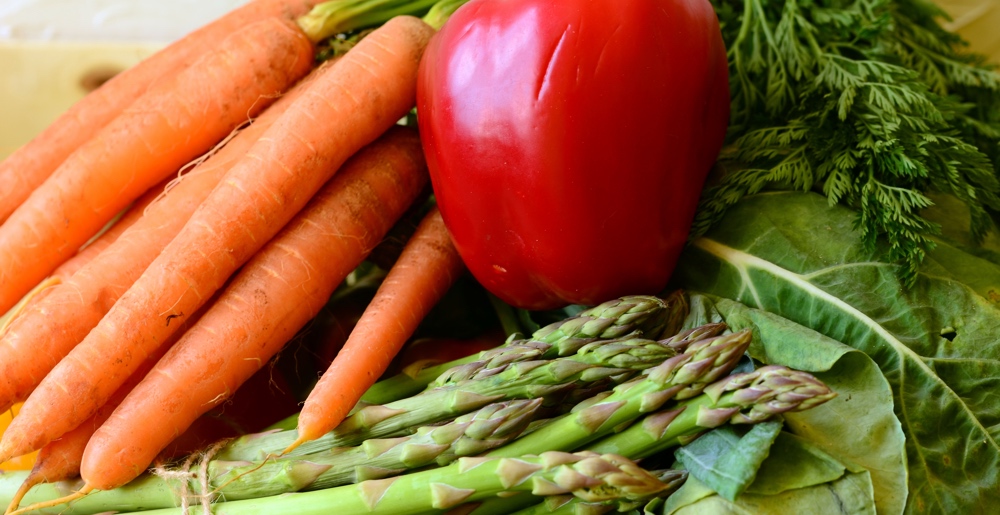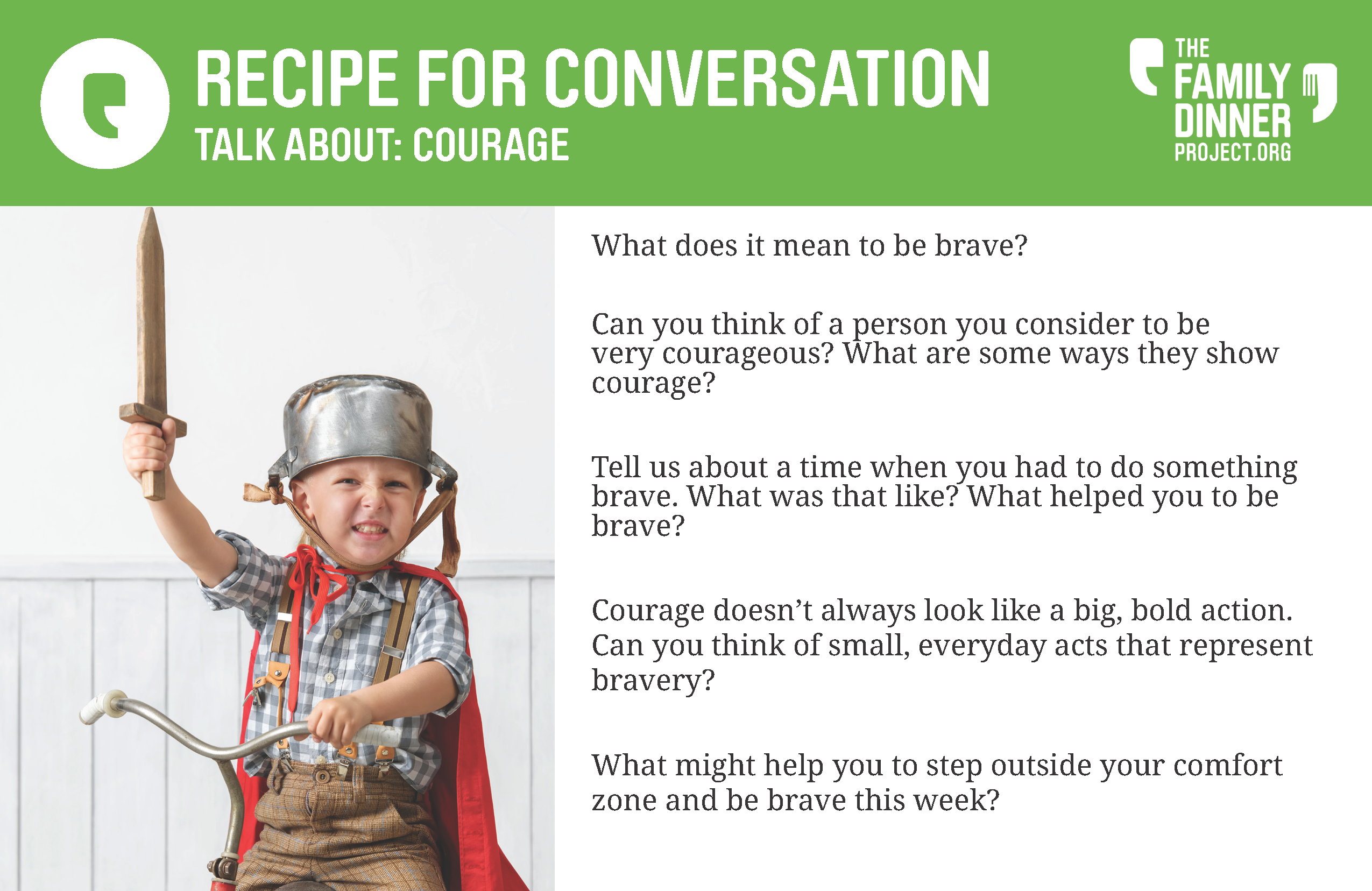Newsletter: September 2019
How to Help Kids Develop Courage

When asked what qualities they’d most like to see their children develop, parents often list courage or bravery among the top ten. It’s easy to see why: it seems as though anxiety is on the rise among both kids and adults. Increasingly, parents share their worries about kids who are too scared to sleep alone, go to school, climb to the top of the tallest playground slide, learn to swim, try a new activity, or any number of other rites of passage. We don’t know for sure what’s causing all this anxiety, but it’s clear that for many families, building courage is an important topic.
What does that have to do with family dinners? Well, for starters, the family dinner table is one of our most reliable daily opportunities to get a “temperature check” on our kids. By sitting down to a meal together, parents and kids get the necessary face-to-face contact to be able to tell whether someone’s feeling down, unusually tired or seeming as though they have a lot on their minds. It’s a perfect chance to check in on whether kids are overwhelmed or anxious, and to find out if something is worrying them.
Family dinner also gives parents a place to teach lessons and reinforce skills and ideals for their kids. Just by being together and combining food, fun and conversation, you can help kids develop character traits like resilience, empathy and yes, even bravery. Here are some ways to build up courage through your family dinners:
- Try new things. It may seem like a small thing, but taking tiny risks — like trying new foods — can help kids feel braver and more confident about stepping outside their comfort zones. If you have reluctant eaters, you might start slowly, with baby steps like encouraging them to allow you to put a new food on the corner of their plate (without a requirement to taste it). Or explore smelling or touching a new food before tasting, and praise their bravery for each new step. With more adventurous eaters, let them explore the produce aisle or farmer’s market for unusual items they want to taste, or make a list of foods they’ve always wanted to try and figure out a plan to make the wish a reality. Do they want to get daring with something spicy? Try an ethnic cuisine you’ve never heard of before? Encourage their explorations and expand your horizons together.
- Talk about courage and risk-taking. One great way to get kids thinking about how bravery shows up in their own lives is to share your own stories. Tell them about the time you took a big risk in middle school, or when you’re talking about your day at work, try using language that reflects courage. “I was so nervous to talk to my boss about what had happened, but I decided that I could take a deep breath and be brave….” You can also share examples of courageous people from the news or from history, or ask kids to talk about book and movie characters who are brave and how those characters show courage. Encourage thinking and talking about bravery as a wide range of actions, too; it’s not only the knight slaying the dragon who’s brave, but also the shy kid who gets up and gives a presentation in front of his class. Courage takes all different forms!
- Model caring for others. Researchers have found that kids whose parents expect them to help those in need are more likely to show courage in a variety of situations. Share ways you’ve stuck your neck out for someone else, and ask kids “How have you helped someone this week?” You can also use the dinner table as a place to make plans to volunteer or help others as a family; our Giving Decision Tree is a great place to start if you’re not sure how to begin brainstorming about a family service project.
- Show them how to balance risk and safety. It’s easier to be brave when you feel confident that you can handle the task at hand. Since it’s not possible to remove all danger from every situation, kids need to be shown how to assess risks and make a plan to avoid unnecessary threats. Cooking together is an ideal activity to help demonstrate those skills! Have kids join you in the kitchen and show them how to manage age-appropriate cooking tasks safely. They’ll learn how to confidently handle everyday risks like using peelers, kitchen shears and eventually knives, how to avoid injury by using potholders and keeping fingers away from heat sources, and how to know when something is too difficult and dangerous for them to try without an adult’s help.
Gaining courage isn’t as easy as following a yellow brick road and asking a wizard for help, so be patient with your kids along the journey. Celebrate the small steps towards increased bravery, and be sure the praise effort rather than results. You may find you even start feeling a bit more bold yourself!
Family of the Month
We’re taking a look back at our archives to recognize some families whose Real Family Dinner Project stories are good examples of courage in action! The Nelson Family and McGrath Family both had to be courageous through international moves, while Gabriela Townsend used her family dinners as a starting point for a brave and bold service project at her school.
Real Family Dinner Projects: The Nelson Family
Real Family Dinner Projects: The McGrath Family
Real Family Dinner Projects: The Townsend Family
Food

Build kids’ courage and confidence in the kitchen by showing them how to safely use a vegetable peeler to make this colorful salad.
Fun

Sometimes kids don’t exhibit courage because they’re scared of failure. Turn “failure” into a celebration with this goofy game!
Conversation
Get the courageous conversation flowing with these questions about bravery.

Recent Newsletters
- Home, and Homemade, for the Holidays - December 2025
- Thanksgiving Traditions, Old and New - November 2025
- Food as Comfort and Care - October 2025
- The State of Family Dinner - September 2025
- Back to School Dinner Success - August 2025
- What’s Your Meal Planning Personality? - July 2025
- A New Guide to Gathering - June 2025
- Celebrating 15 Years of The Family Dinner Project - May 2025
- New Research: Family Dinners Boost Happiness - April 2025
- Just the Two of Us - March 2025
- Ways to Build Community Through Dinner - February 2025
- The Power of Intentions - January 2025
